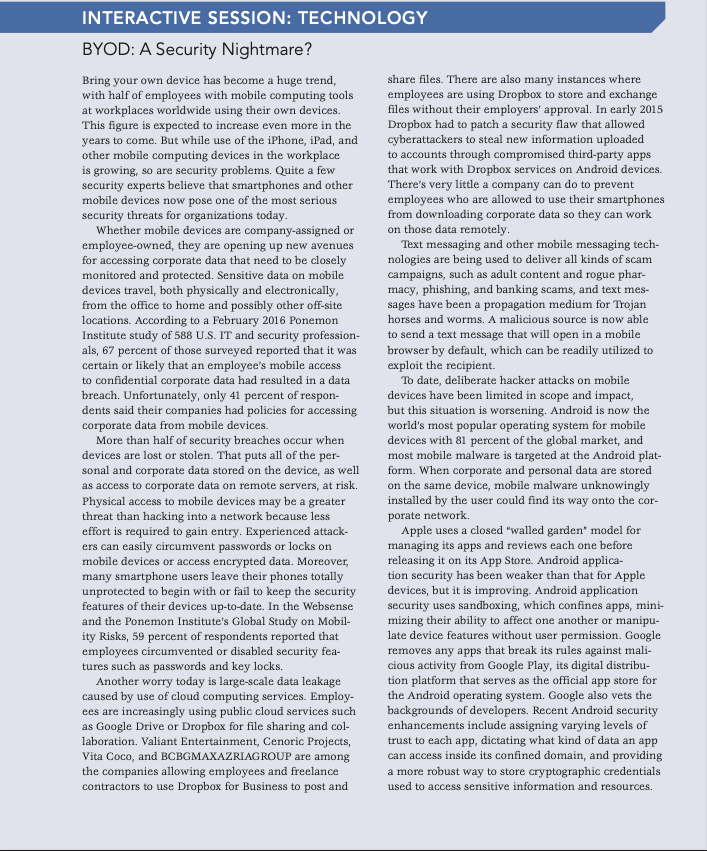What management, organizational, and technology issues must be addressed by smartphone security?
What management, organizational, and technology issues must be addressed by smartphone security?
Chapter16: Managerial Communication
Section: Chapter Questions
Problem 4CTQ: What processes or structures should Facebook establish to make sure it does not encounter these...
Related questions
Question
What management, organizational, and technology issues must be addressed by smartphone security?

Transcribed Image Text:INTERACTIVE SESSION: TECHNOLOGY
BYOD: A Security Nightmare?
share files. There are also many instances where
employees are using Dropbox to store and exchange
files without their employers' approval. In early 2015
Dropbox had to patch a security flaw that allowed
cyberattackers to steal new information uploaded
to accounts through compromised third-party apps
that work with Dropbox services on Android devices.
There's very little a company can do to prevent
employees who are allowed to use their smartphones
from downloading corporate data so they can work
on those data remotely.
Text messaging and other mobile messaging tech-
nologies are being used to deliver all kinds of scam
campaigns, such as adult content and rogue phar-
macy, phishing, and banking scams, and text mes-
sages have been a propagation medium for Trojan
Bring your own device has become a huge trend,
with half of employees with mobile computing tools
at workplaces worldwide using their own devices.
This figure is expected to increase even more in the
years to come. But while use of the iPhone, iPad, and
other mobile computing devices in the workplace
is growing, so are security problems. Quite a few
security experts believe that smartphones and other
mobile devices now pose one of the most serious
security threats for organizations today.
Whether mobile devices are company-assigned or
employee-owned, they are opening up new avenues
for accessing corporate data that need to be closely
monitored and protected. Sensitive data on mobile
devices travel, both physically and electronically,
from the office to home and possibly other off-site
locations. According to a February 2016 Ponemon
Institute study of 588 U.S. IT and security profession-
als, 67 percent of those surveyed reported that it was
certain or likely that an employee's mobile access
to confidential corporate data had resulted in a data
breach. Unfortunately, only 41 percent of respon-
dents said their companies had policies for accessing
corporate data from mobile devices.
More than half of security breaches occur when
devices are lost or stolen. That puts all of the per-
sonal and corporate data stored on the device, as well
as access to corporate data on remote servers, at risk.
Physical access to mobile devices may be a greater
threat than hacking into a network because less
effort is required to gain entry. Experienced attack-
ers can easily circumvent passwords or locks on
mobile devices or access encrypted data. Moreover,
many smartphone users leave their phones totally
unprotected to begin with or fail to keep the security
features of their devices up-to-date. In the Websense
and the Ponemon Institute's Global Study on Mobil-
ity Risks, 59 percent of respondents reported that
employees circumvented or disabled security fea-
tures such as passwords and key locks.
Another worry today is large-scale data leakage
caused by use of cloud computing services. Employ-
ees are increasingly using public cloud services such
as Google Drive or Dropbox for file sharing and col-
laboration. Valiant Entertainment, Cenoric Projects,
horses and worms. A malicious source is now able
to send a text message that will open in a mobile
browser by default, which can be readily utilized to
exploit the recipient.
To date, deliberate hacker attacks on mobile
devices have been limited in scope and impact,
but this situation is worsening. Android is now the
world's most popular operating system for mobile
devices with 81 percent of the global market, and
most mobile malware is targeted at the Android plat-
form. When corporate and personal data are stored
on the same device, mobile malware unknowingly
installed by the user could find its way onto the cor-
porate network.
Apple uses a closed "walled garden" model for
managing its apps and reviews each one before
releasing it on its App Store. Android applica-
tion security has been weaker than that for Apple
devices, but it is improving. Android application
security uses sandboxing, which confines apps, mini-
mizing their ability to affect one another or manipu-
late device features without user permission. Google
removes any apps that break its rules against mali-
cious activity from Google Play, its digital distribu-
tion platform that serves as the official app store for
the Android operating system. Google also vets the
backgrounds of developers. Recent Android security
enhancements include assigning varying levels of
trust to each app, dictating what kind of data an app
can access inside its confined domain, and providing
a more robust way to store cryptographic credentials
Vita Coco, and BCBGMAXAZRIAGROUP are among
the companies allowing employees and freelance
contractors to use Dropbox for Business to post and
used to access sensitive information and resources.
Expert Solution
This question has been solved!
Explore an expertly crafted, step-by-step solution for a thorough understanding of key concepts.
This is a popular solution!
Trending now
This is a popular solution!
Step by step
Solved in 4 steps

Recommended textbooks for you

